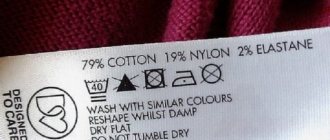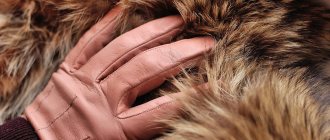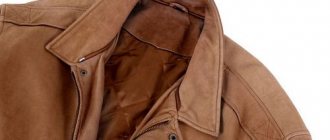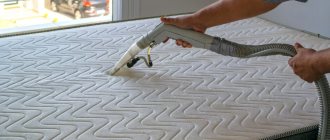Definition
Dry dry cleaning of clothes is a method of cleaning clothes from stains using products that do not need to be dissolved in water. With this method, no liquid is used. The advantage of the procedure is the protection of products from fabric deformation, which cannot be achieved with regular washing.
Manufacturers usually mark washing instructions on clothing. But these tips are not always helpful or may be difficult for people to follow. Dry cleaning your clothes makes it easy to get the job done at home. It is necessary to control the entire process so that the products retain their appearance.
Tips and warnings
In order not to make a mistake in choosing the type of fabric treatment, you need to read the information on the label.
If dry cleaning is indicated there, then you should not experiment with liquid, because the manufacturer believes that this method can extend the life of the product. Machine washing in the wrong mode and aggressive drying with warm air, which leads to overdrying, significantly reduce the lifespan of items. Products with lace, beads and embroidery cannot be machine washed as they will lose their original appearance. Even if the main fabric is cotton, washing such items is prohibited. Rigid materials can also be dry cleaned, as exposure to water can damage their texture.
The correctly chosen option for cleaning the material can not only remove the stain, but also make things look beautiful again.
What items is the treatment suitable for?
What products can be dry cleaned? Delicate fabrics include:
- Silk.
- Wool.
- Fine cotton and linen.
- Thin knitwear.
- Velvet.
- Suede and leather.
If clothes have complex decorative details, for example, hand embroidery with beads, sequins, rhinestones, then they are damaged when processed in a machine, even if a delicate mode is used. The home dry cleaning procedure perfectly preserves the appearance of things. This kind of work should also be done in cases where you want to extend the life of your favorite item. With this processing there is no need to remove buttons, belts, shoulder pads and other parts.
Causes of soiling of sofas
Sources of contamination of sofas
Over a long period of use, any furniture loses its appearance due to scuffs and fading. But the sudden appearance of stains or the rapid growth of dirt on the upholstery is due to the following reasons:
- pieces of food and spilled drinks falling on the sofa;
- formation of stains from blood, drugs and cosmetics;
- children's creativity - traces of paints, felt-tip pens and ballpoint pens;
- dirt and hair from pets that are allowed to lie on the sofa;
- violation of the structure of upholstery fabric due to inept care of it;
- the formation of mold from a wet spot that is not dried in time.
The absence of these reasons does not mean that the sofa can not be cleaned. Dust settling on the coating not only worsens its appearance, but also complicates the removal of stains and leads to the formation of streaks.
How is the procedure performed?
Dry cleaning is performed based on the following steps:
- Things should be placed in a special bag or case. Clothes should lie loosely. Delicate items are turned inside out in advance.
- Place wet and scented wipes in the bag. The moisture contained will allow cleaning to take place. Due to the humid environment, things do not wrinkle.
- You need to turn on the drying mode in the machine. You should set a timer for 30 minutes. The temperature should be minimal.
- After cleaning, hang the clothes on hangers to maintain their shape.
The main reasons for soiling sofa upholstery
When choosing products and tools, you must take into account the upholstery material.
Knowing the risk factors for stains and grime, contamination can be prevented, which is much easier than removing it.
Deteriorate the condition of the upholstery:
- High indoor humidity. Dust particles that fly in the air are attracted to the upholstery of a damp sofa and settle on it, forming a dirty coating.
- Poor quality DIY cleaning. If you do not follow the technology, you can spread dirt all over the upholstery and increase its penetration into the fibers, as well as damage the woven or leather covering.
- Insufficient room insulation. Dust and raindrops fall through open windows and cracks and settle on the sofa cover.
- Lack of personal hygiene. The carelessness of the owners leads to the rapid occurrence of pollution.
Facilities
Dry cleaning is often necessary for delicate materials, such as silk, wool, and fine cotton. Many items can be washed using the “Delicate Wash” mode. For example, clothes made of linen, viscose, triacetate.
If the dry method is chosen, then the work can be done using special chemicals or natural ones. They can be purchased at many household chemical stores or found at home. Most of them are easy to use and affordable.
Manufacturer's labels on down jacket
It is very important to study the manufacturer's labels before taking any action on outerwear. A manufacturer who respects himself and his clothes prescribes what manipulations can be performed with them.
If it can be washed, at what temperature and how. Is dry cleaning allowed?
Hagerty: DryCleanerKit
This dry cleaning kit makes it easy to get great results. The composition contains active substances that can eliminate various stains. It also contains components that refresh the material. The products included in the kit are used for drying in a washing machine.
This stain remover is necessary for cleaning fabrics without harsh solvents, since they are not contained in the composition. The procedure makes clothes fresh, after which the material does not shrink or stretch. The fabric retains its attractive appearance. The set is suitable for processing linen, cotton, silk and wool products.
Wet cleaning of coats
This type of cleaning of outerwear involves the use of liquid solutions. With their help, large and small stains are removed and the product is prepared for washing.
Also, wet cleaning involves using a steamer or iron with steam.
Natural remedies
There are fabrics that cannot be treated with chemicals. They should not be washed, but dry cleaning is quite suitable for getting rid of various types of dirt. If you are sensitive to household chemicals, you can use the following products:
- Scotch. It is great for leather items. It will remove new and old stains.
- Baking soda. The product is considered a natural absorbent that absorbs dirt. The advantage of using it is the availability of soda.
- Starch. The product allows you to remove dirt from clothes.
- Brush. It can be used to clean suede products.
- Sand. Used in the processing of fur products. Heated sand is poured onto the problem area. Then the remains must be shaken off.
- Petrol. Allows you to remove dirt. It is needed to remove serious stains, but due to the strong smell, it should only be used in extreme cases.
- Hydrogen peroxide. The product is considered a natural solvent. It is great for cleaning white items.
- Ammonia. It can remove all stains. It is not used undiluted; ammonia solution is usually used.
- Acetic acid. The concentrated product perfectly refreshes clothes.
Do-it-yourself dry cleaning at home should be done carefully. Before using any product, you must read the instructions. If natural ingredients are used, you should be patient as it will take time to remove the stains. If you are afraid of ruining the item, it is better to contact a specialist. Specialists will perform the procedure with the appropriate product selected based on the type of material.
Home Methods for Removing Stains
Folk remedies for dry cleaning are not always effective. They often have to be used several times to achieve the desired result.
Scotch
Scotch tape will remove any dirt on leather items. Place the adhesive side on the dried stain and tear off sharply.
Do not use tape if the leather item is in poor condition.
Iron
The iron will help clean the traces of machine (vegetable) oil. Cover the stain with paper towels on the outside and inside. Preheat the iron to maximum temperature (look at the item's label). Carefully walk the sole over the stain. The butter will begin to melt and will be absorbed into the napkins.
Baking soda
Baking soda is an inexpensive, effective remedy.
To dry clean clothes, use the following methods for using baking soda:
- Sprinkle the dirty area with washing powder (1 tsp) and baking soda - 2 tsp. Pour 2 tbsp. l. vinegar. Rub with your fingers or a brush. Leave for half an hour. When the powder is dry, shake off the clothing. This recipe will help in removing blood stains.
- Greasey stains from food, foundation or ointments can only be removed with soda. Sprinkle generously onto the stain and shake off after 20 minutes.
- Yellow marks under the armpits are removed with soda and hydrogen peroxide. The components are mixed in equal quantities. The mixture is distributed over the sweat-stained areas and left for half an hour. Residues are removed with a brush.
- If paint gets on the item, you can remove the blot with 1 tbsp. l. soda and ⅓ glass of kerosene. There is no need to mix the ingredients. Kerosene is heated and applied to the contaminated area. The paint will begin to dissolve, then sprinkle with baking soda.
After cleaning, things are hung in a well-ventilated area. This is the only way to remove the smell of kerosene and vinegar.
Starch
Corn and potato starch are used in baking. Luckily, this product helps remove stains without causing any side effects to the fabric.
Application:
- Lay the clothes out on a flat surface and heat the starch. Place a napkin with starch scattered on it under the stain. Rub in lightly and leave for 2-3 hours. Starch absorbs fat.
- Blood stains are more difficult to remove. Sprinkle them with a thick layer of cornstarch and leave overnight. Traces of blood will become light, the procedure must be repeated. After several attempts, the blood will be completely removed.
- Place things saturated with the smell of smoke in a bag, add starch and shake well. If it is a fur collar or fur coat, vacuum it afterwards to remove any residue.
Starch is used to clean car interiors because it is fast, cheap and effective.
Brush
The brushes have rubber teeth. They do not damage the fabric and remove dried stains well.
Suitable for cleaning clothes, carpets and upholstered furniture, suede, cashmere and angora.
Turpentine
Used for dyed wool and silk fabrics. A cotton swab is moistened in clean turpentine and the stained area is wiped. If contamination remains, the procedure is repeated. The remaining trace of turpentine is removed with baking soda.
Grease stains are treated with a mixture of turpentine and ammonia. The components are combined in equal quantities and left on the fabric for 3 hours.
Wood sawdust
Suitable for removing gasoline stains.
What to do: sprinkle sawdust on the stained area and wait until it absorbs the gasoline. If the stain is large, replace the sawdust with fresh ones.
Sand
Woolen fabrics are cleaned with dry sand. It acts like starch. Heat the sand, sprinkle it on the cloth, and leave until it cools. Remove dirt with a brush.
Sand absorbs dust. It darkens after use.
Cleaning with hot sand is an excellent substitute for dry cleaning. This is an environmentally friendly way to remove grease stains and dust from clothes.
River sand is also used for cleaning fur products.
Hydrogen peroxide
Peroxide bleaches things perfectly and is used on white fabrics.
How to use:
- Prepare a solution of 2 parts hydrogen peroxide and 1 part lemon juice. Apply to yellow spots under the armpits, rub lightly and remove with dry wipes.
- Mix 10 ml of hydrogen peroxide and ammonia. Pour the solution onto problem areas. Leave to soak and dry clothes.
Using these methods, you can restore the whiteness of underwear, silk and bed linen.
Ammonia
A universal stain remover that saves you in difficult situations. Most often, ammonia is used in diluted form, but there is a recipe for dry cleaning at home.
Mix ammonia with table salt in a ratio of 4:1. Rub the mixture onto the stained area. Wait for the treated area to dry, remove the residue with a brush.
Removing stains in the machine
Machine dry washing is faster than hand cleaning. How it is carried out:
- Sort your things, zip them up, turn them inside out.
- Place your clothes in a special laundry bag.
- Place napkins (Vanish, Amway) with fragrance or stain remover inside.
- Turn on the “drying” mode, set the minimum temperature and set the timer for half an hour.
- When the wash is finished, hang the clothes on hangers.
Woolen items and natural furs can also be machine washed. At the minimum washing temperature, fabrics will not be damaged. If you can’t get rid of the dirt yourself, you can contact a dry cleaner. In their arsenal, there will probably be products for dry processing of clothes.
Advantages
Dry cleaning of clothes at home is in demand due to the following advantages:
- There will be no deformation of the products since there is no contact with water.
- There are materials that need to be cleaned only using a dry method. This applies to suede, leather, cashmere and other delicate fabrics.
- Some stains penetrate deeper into the material when exposed to water. Then dry cleaning is your best choice.
- Old stains are removed using the dry method. Only with the use of special solvents will it be possible to remove contaminants.
Properties of down jacket filler
Down jackets can have various fillings. And if synthetic ones (holofiber, padding polyester, bio-down, etc.) are easy to wash and dry very quickly, then with natural down everything is not so simple.
Natural down absorbs a lot of water, which causes it to clump and take a long time to dry.
Flaws
This processing method also has disadvantages. Solvents are great for removing grease and oil stains, but they are ineffective when the stains are water-based. Therefore, if the stain is washed at home using the dry method, it cannot be removed.
According to people's reviews, it is clear that solvents gradually spoil the product, since during drying they are not completely removed from the fabric. But this is not true, since the means and technologies used in modern dry cleaners have high surface activity, which increases with heating. Therefore, solvents along with stains are completely removed without causing harm.
Why is it better to use dry cleaning services?
Choosing the wrong product will ruin things: an aggressive stain remover will damage the dye, thin out the fibers of the fabric, and may even cause holes. Some products are harmless for some types of tissue, but can cause irreparable harm to others.
Specialists select products taking into account the type of contamination and material, so they can guarantee the safety of things. Regular cleaning and treatment with special compounds prolongs the life of things. You don’t have to take time off from your household chores and go somewhere: there is a service that offers dry cleaning services with delivery. Specialists will pick up your items, remove even the most difficult stains, and return your clothes clean and ironed.
Features of care depending on the type of upholstery
It is worth remembering that cleaning a sofa directly depends on the type of upholstery. Therefore, you need to know what products can be used for a certain type of furniture upholstery fabric:
- flock, chenille, velor - various greasy stains can be removed with a soap solution using a microfiber cloth; stains from cosmetics and ink can be removed with an alcohol solution. Stains from coffee, tea, wine are removed with powder;
- silk upholstery - in these cases you can use a brush with soft bristles; it must be additionally wrapped in a cotton napkin. Stains are cleaned using a weak solution of peroxide or ammonia;
- Suede upholstery - can be dry cleaned. A soap solution also helps a lot;
- leather - dry cleaning of a leather sofa can be done using a soap solution, medical alcohol or vodka.
Popular articles Boat rack
Genuine Leather
Flock
Suede
If yellow spots appear
If yellow spots form, you need to thoroughly rinse the down jacket and treat these areas with a stain remover (can be replaced with detergent) for 15 minutes, then wash , following the instructions, rinse several times and dry.
One way is to use baking soda. 4 teaspoons per 100 grams of warm water and apply to stains, rub with a brush and leave for 40 minutes. Next, wash, rinse, dry.
Applicable to white items, there is an option with peroxide. Soak a piece of cotton wool in it and treat the yellow spots, rinse and dry.
We also recommend reading the article on how to wash a down jacket in a washing machine and by hand.











